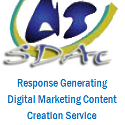Before you excitedly email those pictures to your contacts, do them the favour of reducing the image file sizes (via web optimisation) in a graphics software. Owners or employees in fields like real estate and entertainment, often have to send digital camera, or scanned images (e.g of contracts) to contacts via email.
But doing so without first "pruning" the file sizes by optimising them for viewing on the web, can sometimes create problems for the recipient.
For instance:
(1). His/her email inbox gets clogged because pixs attached to your email are huge.
(2). Even where s/he has access to unlimited email storage, time required to view EACH image may still turn off the recepient..
Web users are not patient people plus, and NOT everyone uses broadband! If you’re in business in my part of the world, you will be wise to take this into consideration when reaching out to clients and prospects with your images.
I wrote this article-tutorial back on 3rd September 2007, to offer some ideas.
However, I encourage you to explore additional options that are now available- including web based services that make it possible to reduce your file sizes online within a matter of seconds.
Three Web-Relevant Graphics File Format Acronyms And Their Meanings
In case you are unfamiliar with the subject of graphic file formats, I provide brief descriptions of the three main graphic file formats used on the web, and which I have mentioned at least once in the body of this article:
a). JPEG means "Joint Photographic Experts Group" : useful for displaying "photographic or continuous tone" images.
b). GIF means "Graphic Interchange Format" : useful for displaying images with large areas of flat colours(e.g logos, icons, and navigation buttons).
c). PNG means "Portable Network Group": An improved replacement format for GIF.
One Example of How Optimise An Image for Viewing On The Web
1. Load the graphics editing software on your PC (If you have none, ask around for advice from people who know, about which one to buy – and where . It won’t take you long to find someone who can help).
Note: in this example, I use Adobe Photoshop 7.0.
2. Click "File-Open" in Adobe Photoshop, then use the "Open" dialog box that appears, to navigate to the folder/location of the image(s) you wish to optimise.
Note: In my case I’ve done this with all sorts of images. One time it was a JPEG graphic of the front cover of my ten ways manual (the Self-Development Bible™) that I had designed for screen printing onto T-shirts I intended to print for sale locally. The initial file size was 1.8MB approx.
I call it up into Photoshop using steps 1 and 2 above.
3. Once it opens, I click "File-Save For Web…" on the main menu and a "Save For Web" dialog interface appears.
4. Looking at the "Settings" panel to the top right, I notice that the JPEG setting (which can be any one of four possible settings for "desired image quality" namely: Low, Medium, High & maximum) is currently set to "Maximum".
A display on the bottom left of the image reads "JPEG (indicating the image’s file format), 1.653M (indicating the displayed image’s size), 603 sec @ 28.8Kbps (indicating estimated image download/view time at 28.8 kilobyte per sec internet connection speed).
Remember : Your purpose is to bring the image size(& by implication the download/online display time) as low as possible without significantly losing image quality.
You need to understand graphic file formats to do this right.
To learn the difference between the different graphic file formats and when it is best to use each one, press F1 in photoshop and click "search" on the browser based help interface that appears, then type "About file formats", and click "Search".
The results page that appears to the right offers – among other things – links to explanations about different file formats. Also there is a link that leads to information about "choosing a Web optimization format".
Explore the links and you should soon be familiar with why JPEG is often the preferred format for web optimisation of photographic images etc.
NB: Another way to learn about the different graphic file formats (such as JPEG, GIF, and PNG) and when best to use EACH is to do a search on the web.
5. Next I click the graphic file formats selection drop menu and choose "Medium". The interface soon changes, and the resulting image display quality still looks acceptable. So I check the bottom left display which now reads: "JPEG (for image format), 339.9KB (for the optimised image’s size), 133 sec @ 28.8Kbps (for the optimised image’s download time at 28.8 kilobyte per sec internet connection speed).
Doing a quick calculation, I am pleased to discover that I have achieved a MASSIVE 81.7% file size reduction (from 1,800KB to 339KB!) using this quick and easy process, without impairing displayed image quality.
Now imagine if I had six(6) such files to email to my friends. Rather than slam their mail boxes with 10.8 MB worth of picture attachments, they will only have to contend with approximately six files totalling 2 MB altogether(!) – each of which would take about 122 secs to download at 28.8kbps. But it’s actually likely to be BETTER than that because in reality, the simplest/most basic net connections today run at 56kbps and higher, so that it would actually take 60 seconds or less to view the optimised images!
6. Next I click the "Save" button to accept the optimised image. Then I navigate to the desktop using the "Save Optimised As" dialog box drop menu, and add "_optimised" to the default filename of the image.
Next, I click "Save" to store the new image to the desktop, where I will later find it and send it as an email attachment to an acquaintance for his comments.
Note that not only does the optimised image look almost (if not just as) clear as the original, it also has the exact same dimensions, so nothing really is lost – at least to the human eye, which is the benefit of the lossy compression format called "JPEG".
Summary: Web Users Are a "Click-Happy" (i.e. Impatient) Lot, So, to Keep Their Attention, Employ Methods and Formats That Ensure Speedy Delivery of Quality Content!
Many people come online in a bid to quickly check their mails or find some information or upload some data etc. Quite often, this causes them to have little time or patience to "WAIT" for top- heavy web pages or "fat" images to download.
As a result they tend to be "click-happy" – and if your pictures take too long to appear – could "click away " to do other more pressing things (possibly promising themselves they will come back another time to view the lovely pictures – but often "forgetting" to do so).
If you really want people to take time to look at the pictures you send to their email boxes, make the extra effort to optimise those pictures(using any good graphics application) for quick/easy display on the web.
Most good graphics editing software will offer something similar to Adobe Photoshop’s "Save for Web" tool.
Play around with with your program a bit, read up the instructions provided in the Help section, and you should soon be up to speed with making your pictures/images web optimised AND viewer-friendly 









Warning: count(): Parameter must be an array or an object that implements Countable in /home1/tayoswdg/public_html/sdnuggets/wp-includes/class-wp-comment-query.php on line 399